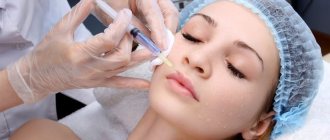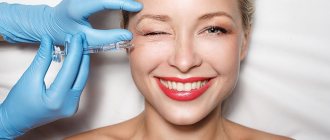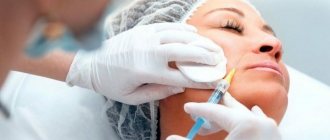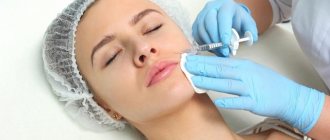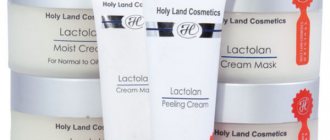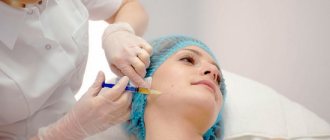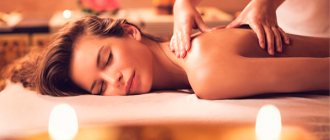From this article you will learn:
- Facial mesotherapy – what kind of procedure is it, reviews,
- what drugs are better to choose,
- before and after photos, price 2022,
- mesotherapy or biorevitalization: which is better.
Mesotherapy is a method of intradermal administration of active components, which can be aimed at rejuvenating the skin of the face and neck, improving the condition of hair, treating problematic skin in patients with acne and seborrhea, as well as combating local fat deposits and cellulite. The method was invented by the French physician Michel Pistor in the 60s of the last century, and was initially used only for the treatment of cellulite.
There are a huge number of active ingredients that are used in mesotherapy preparations. Preparations for the prevention and treatment of skin aging usually contain various combinations - hyaluronic acid, vitamins, microminerals, antioxidants, amino acids, regulatory peptides, nucleotides. Moreover, the composition of the drugs is selected for each patient individually - taking into account age, type of skin aging, the presence of hyperpigmentation or rosacea.
For local obesity and cellulite, lipolytics (phosphatidylcholine, deoxycholate, L-carnitine, etc.) are used. But the most widely used group of drugs in mesotherapy are vascular and drainage drugs, for example, “Artichoke”, “GAG Complex DVL Capyl” and others. They are used not only in complex treatment programs for cellulite and local fat deposits, but also occupy one of the leading places in rejuvenation programs for patients with deformational (edematous) type of aging.
Classic mesotherapy involves injection of active components into the dermis or subcutaneous fat. Injections are made with very thin 30, 31 or 32G needles (32G needle diameter = only 0.23 mm). The so-called fractional mesotherapy of facial skin, where mesococktails are used in combination with the DermaPen device or mesoscooters, shows good effectiveness. Less effective is the so-called needle-free facial mesotherapy (using pulsed iontophoresis devices), but it is indicated for patients with a tendency to keloid scars.
Indications for mesotherapy of the face and neck –
- Therapy and prevention of biological aging of the skin - in order to improve the color, texture, elasticity of the skin, reduce the depth of wrinkles and folds,
- therapy and prevention of photoaging (increasing skin hydration, correction of hyperpigmentation and rosacea),
- improving the skin condition of smokers,
- local obesity (double chin, fat bags on the face),
- problematic skin with acne,
- preparation for medium/deep chemical peels, plastic surgeries, as well as rehabilitation after them.
Local fat deposits on the face are a separate big topic, which we discussed in the article on correcting a double chin.
Nevertheless, it must be said that the use of lipolytics in combination with drainage drugs is also indicated in complex rejuvenation programs for patients with deformational (edematous) type of aging, making it possible to reduce the volume of soft tissues, the depth of folds, and the severity of gravitational ptosis. Speaking about mesotherapy for acne, it is worth noting that injections of mesopreparations can only bring the patient out of an exacerbation, reducing the number and severity of inflammatory elements. But as for the correction of atrophic scars after acne, fractional mesotherapy (using DermaPen or a mesoscooter) works better here. By the way, the same situation is with stretch marks on the body - classical injection mesotherapy is completely ineffective here, and fractional mesotherapy is quite the opposite.
Advantages and disadvantages
The procedure has many advantages:
- Safe composition of the drug;
- Wide range of indications;
- Efficiency;
- Increased skin turgor;
- Improved complexion;
- Help in treating acne;
- Elimination of rosacea;
- Normalization of sebum production;
- Lifting effect;
- Lightening pigment spots;
- Relief leveling;
- Stimulation of hair growth on the head;
- Lasting results;
- Possibility to combine with other treatment methods.
There are significantly fewer disadvantages, and even those are very conditional. These include:
- Preservation of papules (small lumps) immediately after the procedure - injection marks will disappear within a couple of days;
- A small number of contraindications.
Features of facial mesotherapy and its differences from biorevitalization -
Many patients do not understand how mesotherapy differs from biorevitalization, because in principle these are very similar techniques, which use both the same injection techniques and similar active components. But nevertheless, these differences are very important, and will allow you to decide how suitable one or another method is for you. The main differences lie in the characteristics of the drugs used, so let's take a closer look at how mesopreparations differ from biorevitalizants.
The first difference is that mesotherapeutic preparations use much lower concentrations of active components. For example, in mesopreparations the concentration of hyaluronic acid (HA) is usually 0.3-0.5% (rarely up to 0.8-1.0%), and in biorevitalizants it is most often no less than 1.8-2.0%. The second difference is that mesopreparations contain, as a rule, low molecular weight HA (with a molecular size of 200-800 kDa), while biorevitalizants contain high molecular weight HA, from 1800 to 3000 kDa.
It should be noted that the larger the size of the hyaluronic acid molecules, the more pronounced the moisturizing effect of the drug on the skin will be, and secondly, the slower the HA molecules will be destroyed under the influence of the hyaluronidase enzyme, which means the effect of the drug will last longer. The third difference concerns the form of release of the drugs. Mesopreparations are produced on a water or sol basis (sol - liquid gel), which means rapid distribution in tissues, as well as very rapid elimination.
That is why mesotherapy procedures on the face and neck are done once a week. But biorevitalizants are always produced in the form of viscous gels, which improves the deposition of active substances at the site of each injection. The gel will dissolve more slowly, which means the active substances in its composition will act on the tissue longer. Therefore, biorevitalizants are usually administered once every 2 weeks, but there are preparations containing stabilized HA that can be administered only once every 3-4 weeks.
Important: thus, for biorevitalization, drugs are used that allow achieving more intense rejuvenation (the cost of biorevitalizants is many times higher than the cost of meso-preparations). Based on all of the above, you should understand why the cost of 1 mesotherapy procedure usually starts from 2,500 rubles, and biorevitalization - on average from 9,000 rubles or more for 1 procedure. Different properties of the drugs create differences in the frequency and number of procedures.
For example, mesopreparations are done once a week, and in patients 35+ the course will usually consist of 10-12 procedures, while biorevitalizants are done once every 2-3 weeks, and the course will consist of 3 to 7 procedures (depending on the severity of age-related changes). As for relatively young patients who seek prevention or only minor correction of changes, short courses of mesotherapy will be preferable for them. But for patients 45+ (and even more so after menopause), mesopreparations will no longer work at all.
→ Rating of drugs for biorevitalization
Drugs used in the procedure
Our specialists will select the composition of the meso-preparation for you in accordance with the needs of your skin or hair and develop a treatment program to rid you of imperfections in your appearance in a short time. We work only with modern, completely safe drugs from the world's leading manufacturers. All meso-cocktails used in Cleo Line have undergone clinical trials and confirmed their effectiveness. The active ingredients begin to work immediately, and a pronounced cumulative effect is observed.
Mesotherapy and types of skin aging: important
From the outside it may seem that mesotherapy is a very simple technique - you just need to take a more expensive drug with a large number of active ingredients and inject it over the entire area of the face and neck. And so several times, and continue to wait for the onset of rejuvenation. And it seemed like everything was done, but for some reason rejuvenation never came.
Of course, perhaps you initially had too high expectations from the course of mesotherapy, and you refused biorevitalization due to price considerations. However, it is also possible that the treatment was carried out without taking into account individual characteristics, for example, the type of skin aging. Russian women are characterized by 2 main types of aging - these are primarily deformational (edematous) and finely wrinkled types of aging. But, of course, no one has canceled the mixed and tired types of aging either.
Producing countries and popular brands of mesoctails
Popular pharmacy brands do not produce concentrates for aesthetic mesotherapy, so you can buy them from a distributor, cosmetologist or in specialized stores. Mesococktails differ in cost, methods of application, and duration of therapy.
Russian
The advantage of Russian mesotherapy drugs is their reasonable price. The production of cocktails, as well as other materials for cosmetology, is actively developing in Russia. Mesococktails perform the entire range of cosmetic care (rejuvenate, restore, moisturize, heal).
Names of popular Russian brands:
- Plazan;
- Active Plus (Active+, co-production with Switzerland);
- Alpika;
- Skinasil.
Japanese
Among Japanese brands, Russian cosmetologists actively use Demax. The basic function of these drugs is an anti-aging effect. They comply with the European GMP quality standard and undergo clinical trials.
In addition to concentrates for mesotherapy, the range includes products for daily home care of the face and body, for treating skin from acne, demodicosis, and dermatitis.
Korean
Major cosmetic brands produce cosmetics in South Korea. Concentrates are used for a wide range of dermatological problems and are developed taking into account modern biotechnologies. Names of Korean drug brands:
- Cell Fusion C;
- Dermaheal;
- CS Lab, Lipo Lab;
- Witten;
- Meeto.
Spanish
Spanish meso-cocktails are in demand among Russian cosmetologists. Products made in Spain are characterized by multi-component compositions, biotechnological developments, and reasonable prices. Large manufacturers of cosmetic preparations:
- Fusion;
- WORLDDERMIC (Amdermic SL);
- NEOvial;
- BCN;
- Veluderm;
- Mesoestetic;
- Toskani Cosmetics.
French
These meso-cocktails are not inferior in quality to skincare or decorative cosmetics produced in France. Quality certificates, clinical studies, and high technologies make French cosmetic brands market leaders. Among them:
- MesoEXPERT;
- Filorga;
- BeautyPharma;
- Revitacare;
- Kosmoteros.
How does the mesotherapy procedure work?
Injections of mesopreparations: photo
As we said above, injections of mesopreparations are made using a syringe and very thin needles 30, 31 or 32G (needle diameter 32G = only 0.23 mm). In mesotherapy, there are 4 main injection techniques - nappage, papules, tubercles, and linear-retrograde technique. Anesthesia will be required before the procedure begins. Pain relief during mesotherapy of the face and neck is carried out using a cream or gel based on the anesthetic lidocaine (in concentrations from 5 to 12%). The cream is applied to the face under the film for 20 minutes.
Above, we already told you about lymphatic drainage vascular injection of the face and neck (capillary mesotherapy), which is necessary to activate lymphatic drainage and blood supply to the skin. This is necessary both for patients with finely wrinkled type of skin aging, and especially for deformational/edematous type of aging. But if with the finely wrinkled type the vascular injection is done only in the first 1-3-5 procedures (we look at the condition of the skin and age), then with the deformation type the vascular injection should be done in each of the 10-12 procedures.
Lymphatic drainage vascular puncture technique –
During mesotherapy of the face and neck, a vascular puncture will activate the regional lymph nodes of this area, improve lymphatic drainage, relieve swelling of the dermis and subcutaneous fat, strengthen the walls of blood vessels, and also reduce the volume of fat bags on the face and neck. For example, your wrinkles, jowls or double chin will also be reduced. For vascular/lymphatic drainage injection, drugs such as “GAG Complex DVL Capyl formula”, “Gingko Biloba”, “Artichoke”, “Rutin + melito extract” are used.
Small injections are made into certain areas: the entire cervical-collar area (to the level of the shoulder blades), on the face and neck - in the projection of all groups of lymph nodes. If there is a large volume of fat on the face and neck, we can also pierce the middle/lower third of the face along the massage lines + the entire second chin. The volume of vascular preparations for 1 procedure is 5 ml. And only after this (in the second part of each procedure) we do injections of mesopreparations aimed at rejuvenation.
Another option is not to use age-correction drugs at all during the first 2-3 procedures, but to combine vascular lymphatic drainage injection on the face and cervical-collar area with the use of soft lipolytics. Lipolytic injections are made in the area of excess fat, such as lip bags, nasolabial folds, jowls and double chin. And starting from the 3-4th procedure, we begin to combine vascular drugs with mesopreparations intended for age correction.
Mesotherapy injection techniques –
There are only a few of these techniques, and below you can read not only their descriptions, but also see videos demonstrating them. Please note that injection techniques in mesotherapy and biorevitalization are completely the same, so do not be embarrassed if the term biorevitalization sometimes appears in the videos below. The process of injecting the mesopreparation usually takes no more than 15-20 minutes (not including time for lymphatic drainage vascular injection, anesthesia, and a regenerating mask after the procedure).
1) “Nappage” technique (superficial, middle, deep) – with superficial nappage, the tip of the needle does not penetrate the dermis, i.e. the doctor works only at the depth of the epidermis, which will mean the absence of blood discharge from the needle insertion points. This technique is characterized by too much consumption of the drug, which must dry on its own. In theory, this should help the active substances penetrate the dermis, but in fact this is the most ineffective of mesotherapy techniques.
The median nappage technique is much more effective, and in this case microdoses of the drug will enter the upper layers of the dermis to a depth of 1-1.5 mm (hence, there will definitely be blood dew from the injection sites). With each needle insertion, only 1 drop of the drug is released, which usually does not cause the formation of papules, or they quickly disappear. But the deep nappage technique is used in patients with thick skin and is distinguished by the fact that the needle is inserted already at 2-3 mm.
Nappage: superficial (video 1) and middle (video 2)
2) “Papules” technique (superficial or middle) - this technique involves injections into the upper or middle layers of the dermis, so that at the site of each injection a “papule” will appear, which looks like an elevation above the surface of the skin. The size of the papules will depend on the volume of mesopreparation injected into the tissue at each needle insertion point. Papules can be small (about 1-2 mm) - in this case they are called micropapules. The volume of the drug at each point will be about 0.01-0.02 ml, and the distance between them will be from 0.3 to 0.5 cm. Such papules are made in areas with thin skin, for example, in the periorbital zone.
In areas with denser skin, papules are made to a standard size, i.e. with a diameter of 3-4 mm. The volume of the drug at each point will be about 0.03-0.04 ml, and the distance between injections will be about 1.0-1.5 cm. Keep in mind that the larger the papules, the slower they will dissolve. Usually papules disappear within 2-3 days, less often - up to 5-7 days. Sometimes papules can take up to 2-3 weeks to resolve, but this is usually due to a doctor’s mistake (when a cosmetologist administered a drug based on stabilized HA in the form of standard papules, which cannot be done).
Papule technique: video
3) “Tubercles” technique – if the previous technique involves introducing mesopreparations at an angle of 15 degrees to the surface of the skin (into the superficial and middle layers of the dermis), then in this case the drug is injected with a 32G needle at an angle of 45 degrees to the entire depth of the needle. In this case, the drug depot is created in the deep layers of the dermis, at a depth of approximately 3 mm. This technique is distinguished by the absence of elevations on the surface of the skin in the form of papules, and after the procedure only traces of needle injections will be visible. However, this technique has a greater risk of hematomas.
4) Linear-retrograde technique - technically this technique is the most complex, and it came to mesotherapy from contour plastic surgery. If for all previous techniques 4 mm needles are most often used, here they are 12-13 mm long. After injection, the needle moves into the dermis parallel to the surface of the skin over its entire length. The drug is eliminated when the needle moves backwards in a retrograde manner. This is the most effective mesotherapy technique, although it is more traumatic. But the fact is that in this case, additional trauma to the dermis is a plus - the body responds to it with regeneration and an increase in collagen synthesis.
Linear-retrograde technique: video
History of the procedure
The procedure was first tested by a doctor from France, Michel Pistor: in 1952, he subcutaneously injected a complex of vitamins into his patient. The effectiveness appeared immediately, Pistor continued his research and found out that the same drug, which is administered to different points of the body and in different doses, will give a different therapeutic effect.
The procedure has changed noticeably by now: now mesotherapy allows you to achieve the desired result - rejuvenation and getting rid of aesthetic defects - which lasts for 1-1.5 years.
Facial mesotherapy before and after: photos, reviews
On the websites of cosmetology clinics you will almost never find real photos before and after facial mesotherapy, because... To sell procedures, clinics only post photos of successful treatment cases, or even more often, they post photos of patients after hardware rejuvenation techniques - as if they had undergone a course of mesotherapy. However, you should know 2 important points. Firstly, the effectiveness of the same drug (even though the same number of procedures were performed) can vary greatly in different patients.
And secondly, facial mesotherapy, by definition, is much weaker than biorevitalization, and therefore it cannot achieve very pronounced changes, especially if you have aged but well-groomed skin. But if you have never paid much attention to your facial skin before, the effect of mesotherapy will certainly be obvious. Below we present cases of clinical treatment in patients aged 35+ and 45+.
Example #1 –
Shows the effectiveness of facial mesotherapy with a single preparation of hyaluronic acid. The following photographs are taken from an independent clinical study. Each patient was injected with 2.0 ml of Restylane Vital (a monopreparation of 2% partially stabilized hyaluronic acid) during 1 procedure. Moreover, the course of treatment consisted of 3 procedures performed with an interval of 4 weeks.
Facial mesotherapy: before and after photos
As you can see, the effect of using even a single course of hyaluronic acid in patients aged 35 and 46 years is practically not noticeable. Such drugs, in our opinion, are best used to prevent aging at a younger age, but not for age correction.
Example No. 2 –
The following photos were taken by cosmetologist Victoria Petrovskaya. The patient underwent a course of 4 procedures (with a frequency of 1 time every 2 weeks). At the beginning of each procedure, a lymphatic drainage vascular injection was first performed with the drug “GAG Complex DVL Capyl”. Then, for each procedure, the mesopreparation “Hydro Line P-Anti-wrinkles” was used for the periorbital area, and “Hydro Line Peptide” was used for all other areas of the face. The after photos were taken after the second procedure.
Example No. 3 –
The photographs below were taken by cosmetologist E. Kuvshinnikova. The patient underwent a course of 5 procedures. The first 3 procedures used the drug "Hydro Line" (with a frequency of 1 time - every 7-10 days), and in the last 2 procedures - the meso drug "Hydro Line Peptide" (with a frequency of 1 time in 2 weeks). Capillar mesotherapy was not carried out, but, of course, a positive effect was achieved. But in the following example you can see how effective biorevitalizants or their combinations with mesopreparations can be.
Example No. 4 –
The photos below were taken by cosmetologist Irina Pyagai. The patient underwent a course of eight procedures (with a frequency of 1 time in 10 days). At the beginning of each procedure, a lymphatic drainage vascular injection was first performed with the drug “GAG Complex DVL Capyl”. After this, rejuvenation drugs were used in each of the eight procedures. Please note that in this course of treatment a combination of biorevitalizants (in the first 5 procedures) and mesopreparations was used in the last 3 procedures.
"Nucleospire Revitalizing Complex A"- "Hydro Line Revitalizing Complex B formula",
- "Nucleospire DNA-RNA 2%",
- "Hydro Line Revitalizing Complex B formula",
- "Nucleospire DNA-RNA 2%",
6,7,8 procedures – mesopreparation “Nucleospire DNA-RNA 1% DM Peptide”.
What happens to the skin after injections
The first half hour after the procedure, the face turns a little red, and mild discomfort occurs. Small compactions may form at the injection site, which will last for 24 hours.
At this time, the following changes occur in the epidermis:
- the pharmacological effect of the drug used is manifested;
- blood circulation improves;
- cell regeneration processes are accelerated;
- nutrients are supplied to each cell.
Mesotherapy procedures have a cumulative effect, so that comprehensive changes will be achieved approximately 2-4 weeks after completion of the full course. However, the first manifestations will be visible immediately after the first procedure.
How much does facial mesotherapy cost – price 2022
If you decide to undergo facial mesotherapy, the price for 1 procedure will depend on the cost of the drugs administered, as well as the pricing policy of the clinic. In advertising you can often see that for facial mesotherapy the cost of 1 procedure starts from only 2,500 rubles, however, if we are talking about high-quality drugs, then this amount is only the minimum cost of consumables.
For example, we decided to do a lymphatic drainage vascular injection with the drug “GAG Complex DVL Capyl”. Only its cost for 2022 will be 300 rubles. Then we take the cost of one of the above drugs - this is another 800 to 1400 rubles. You also need all kinds of consumables (several expensive 30 and 32G needles for injections, sterile sheets, gloves, the cost of anesthesia and many other little things) - that’s another few hundred rubles. Thus, 1600-2000 rubles is only the cost of materials.
But prices should take into account the costs of training a mesotherapist, and rent, and depreciation of equipment, and wages. Typically, for frequent cosmetologists the markup is + 100-150%, and for private cosmetology clinics the markup is + 150-200% (to the cost of all consumables). Thus, the normal price, for example, for the above complex with vascular injection and the drug “Hydro Line Extra” should be at least 4000-4500 rubles.
Important: but if we take more expensive drugs from a series of biorevitalizants, for example, “Nucleospire DNA-RNA 2%” (2.0 ml), only the cost of which is 4000 rubles, then the final cost of the service together with the vascular injection should not cost any less 9000 rubles. And here we gradually come to the question of why some patients have negative reviews of mesotherapy, and they say that it does not work. Yes, simply because, for example, cosmetologists almost never perform capillary mesotherapy on patients.
The latter takes a lot of time (and time is money), plus it takes a long time to explain to patients why this is needed at all. It's easier not to do it at all. Secondly, the right drugs and their combinations are not always used - which we told you so much about above. As a rule, this is due to the low qualifications of specific mesotherapists. Well, as we have already said, in older patients with well-groomed skin, mesotherapy of the neck and face will not give a good effect; other drugs are needed.
→ Cost of facial biorevitalization procedures → Cost of hair mesotherapy procedures
Active components in mesocotails
Cocktails for face and body mesotherapy are made in several ways:
- monopreparations from one component differ in their targeted action (for example, with hyaluronic acid to preserve moisture in all layers of the dermis and deep hydration);
- formulations with several components contain vitamin complexes, minerals, extracts and pharmaceutical substances, and are therefore used for a wide range of dermatological problems;
- meso-cocktails made by a cosmetologist himself.
Minerals
Mineral salts of selenium, potassium, sodium, silicon, zinc and magnesium in the composition of preparations for mesoscooter enhance the reaction of enzymes. These substances control oxygen and protein metabolism, reduce pigmentation, and regulate the functions of the sebaceous glands. For mineral deficiency:
- the skin becomes pale, dryness and flaking increase;
- Hair grows slower and hair often falls out;
- rashes, acne, eczema appear;
- there is a lack of keratin, the balance of hormones is disturbed;
- the skin fades faster.
Vitamins
Injection of vitamins ensures their rapid absorption by the body. With mesotherapy, they are better absorbed and begin to work immediately. What effects do vitamins in mesococktails have:
- retinol - regenerates cells, increases the resistance of the upper layers of skin and hair to negative effects (ultraviolet radiation, high temperatures, cosmetics);
- B vitamins - improve complexion, moisturize and soothe the skin, prevent dryness and flaking, reduce swelling; with deficiency, dermatitis, dandruff, and eczema develop;
- ascorbic acid - participates in the synthesis of antioxidants and collagen;
- calciferol - helps increase immunity, cell production and renewal, protects the skin from infections;
- tocopherol - slows down the aging process, nourishes and smoothes the skin;
- linoleic acid - has an anti-inflammatory and calming effect, increases the resistance of the dermis to temperature changes;
- rutin - helps against pigmentation, rosacea due to its strengthening effect on blood vessels and tissues.
Acids
Organic and fruit acids in the composition of the preparations:
- Glycolic - used for anti-aging therapy and skin whitening, helps against age spots, freckles, the effects of acne or pimples. Suitable for problematic and oily skin, as it has a peeling effect (removes dead skin particles, renews), relieves inflammation and disinfects.
- Lactic - mild scrubbing and exfoliating actions allow the use of acid for sensitive, redness-prone skin. The substance regulates the functioning of the sebaceous glands, prevents clogging of pores and the appearance of comedones. Suitable for aging skin, as it accelerates regeneration processes and deeply moisturizes.
- Pyruvic acid - the substance does not cause allergic skin reactions, evenly tones and rejuvenates without damaging the epidermis. It is used for dry, mature and problematic skin due to its universal effects: moisturizes, does not tighten, tightens pores, heals.
Plant extracts
Concentrates from different parts of plants enrich meso-cocktails with essential oils, vitamins, enzymes and other active substances. The following plant extracts are used:
- aloe is an anti-inflammatory, moisturizing substance to protect sensitive, dry or problematic skin;
- green tea - strengthening, tonic effect and acceleration of intracellular metabolism (used as part of anti-cellulite mesopreparations);
- pomegranate - for saggy, sagging skin prone to swelling, regulates water balance, promotes collagen synthesis;
- grape seeds - increases tissue restoration, promotes skin healing and smoothes scars (post-acne, acne marks, scars);
- grapefruit - rejuvenates, strengthens and whitens the skin, evens out complexion and acts as a fat burner;
- lemon - peeling effect to exfoliate the epithelium and cleanse the pores.
Medications
Pharmaceutical components of meso-cocktails are used to treat dermatological problems:
- ergotamine, dihydroergotamine - strong vasoconstrictors (for the treatment of rosacea, rosacea), extracted from the toxic fungus ergot, so the drug is administered only under the supervision of a cosmetologist;
- alpha-lipoic acid - prevents the formation of sugar on the elastin and collagen framework, which helps protect the skin from sagging, smoothes it and rejuvenates it, treats acne, acne, demodicosis;
- amino acid levocarnitine - participates in fat, carbohydrate, and water metabolism, strengthens blood vessels and prevents the development of rosacea, often used as part of lipolytic cocktails.
Animal extracts
Instant lifting is provided by concentrates similar to substances that are synthesized in the human body. Intercellular matrix proteins (elastin, collagen), glycoproteins, nidogens, macrophages strengthen and tighten the skin, rejuvenate it at the cellular level.
Biotechnology Products
Artificial additives designed to enhance the mesoeffect:
- highly polymerized DNA - a substance synthesized from the seminal glands of salmon fish for cellular regeneration and skin rejuvenation;
- hyaluronate is a binding component of epidermal fibers, which provides skin hydration and nutrition and hydrophilic properties;
- placentex - enhances cellular metabolism, increases elasticity and heals skin prone to inflammation.
On our website we have a large selection of high-quality meso-cocktails and mesotherapy preparations.
Mesotherapy at home –
Mesotherapy at home is possible using special devices. The most effective is the use of a fractional mesotherapy device called DermaPen. This device is easy to use and costs only 6,000 rubles, which is quite a bit compared to the cost of a full course of mesotherapy. A cheaper version of this device are mesoscooters.
The latter are also effective for solving aesthetic problems, but due to some features of mesoscooters (you can read about them at the link below) - when used regularly, they lead to roughening of the facial skin. But the use of DermaPen does not lead to such consequences. In addition, both of these fractional mesotherapy devices are more effective against atrophic acne scars than the classic injection technique. However, you can get the maximum effect here - from a combination of DermaPen + injections of nucleotides and matrikin peptides.
→ Reviews about the DermaPen device → Reviews about the use of mesoscooters
There are also devices for needle-free mesotherapy based on iontophoresis (Fig. 16), which can be bought in special medical stores. With this technique, the skin is not injured by needles, and the device increases the permeability of the skin for mesotherapy serums. For iontophoresis procedures, mesoscooters and DermaPen, specially designed serums containing only low molecular weight active substances should be used.
Who performs the procedure
In the clinic, mesotherapy injections are performed only by experienced, qualified specialists with specialized education. All doctors who work at Cleo Line have received not only their main specialty. They have also undergone professional retraining in cosmetology, constantly improve their skills, and participate in trainings and master classes. The specialists are assisted by cosmetology nurses who also have the necessary professional knowledge.
The experience and education of each clinic specialist can be found on his personal page.
Mesotherapy: contraindications
Below we have provided a detailed list of contraindications for mesotherapy. Particular attention should be paid to oncology, the patient’s predisposition to the formation of keloid scars during the healing of skin wounds, and thyroid diseases. Mesotherapy is contraindicated for –
- pregnancy and lactation,
- the presence of any oncology (even in the past),
- allergies to drug components,
- when taking anticoagulants or antibiotics,
- during acute inflammatory diseases,
- during exacerbation of skin diseases,
- with psoriasis, hepatitis or HIV,
- against the background of high or too low pressure,
- for epilepsy and psychosis,
- with a tendency to keloid scars,
- for autoimmune diseases,
- for diabetes mellitus (any type).
In addition, girls and women need to take into account that the risk of hematomas will be higher - in the period 2-3 days before the onset of menstruation and + 2-3 days after their end (this is due to a decrease in blood clotting during this period). We hope that our article on the topic: Facial mesotherapy before and after photos, reviews – turned out to be useful to you!
Sources:
1. Add. professional
, 2. Personal experience of clinical application, 3. National Library of Medicine (USA), 4. The National Center for Biotechnology Information (USA), 5. “Aesthetic mesotherapy” (Tochinova N.A.).
What cosmetic preparations to use for home mesotherapy
So, to carry out the beauty procedure you will need a dermaroller and a special cocktail. What you can use:
- vitamin cocktails with groups A, E and C
- minerals, particularly magnesium and silicon, which support connective tissue
- aluronic and polylactic acid for a rejuvenating effect
- extracts of animal or plant origin
- lipolytic drugs and enzymes
- stimulators of elastin and collagen production.
